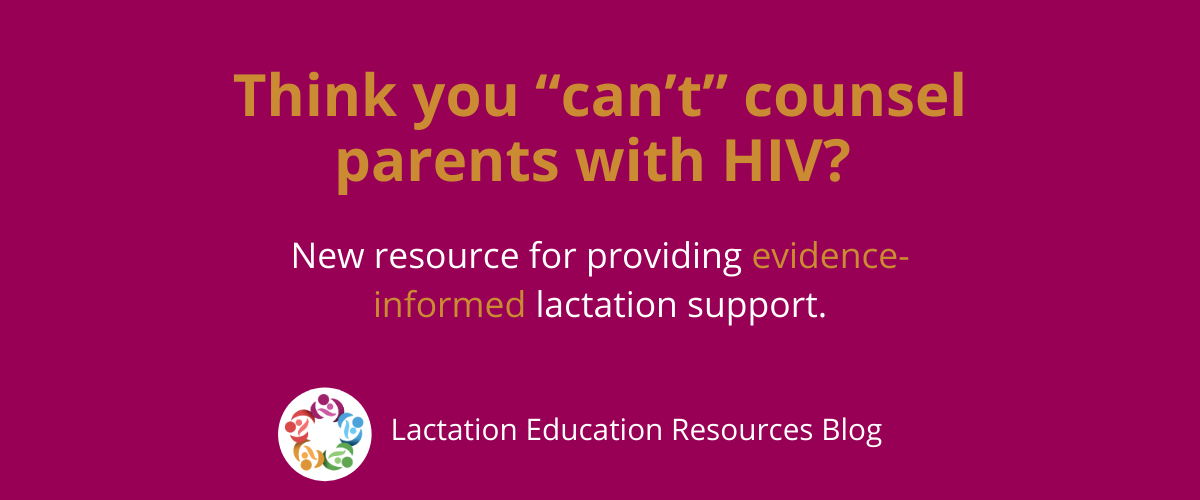Think you “can’t” counsel parents with HIV? New resource for providing evidence-informed lactation support.

You get a call from a prenatal client who discloses that she is living with HIV. She asks you whether she can safely breastfeed her baby. Do you know how to answer?
On a new client history form, a mother includes antiretroviral therapy (ART) on her medication list. She tells you she is feeding her baby her milk but would like to also feed formula. Do you know whether this is a safe option?
An exclusively breastfeeding client asks for your help with sore and damaged nipples. She tells you she is HIV positive, and she’s worried that her damaged nipples may put her baby at risk for HIV transmission. Do you know how to counsel her?
Dayna Hall, BS, IBCLC, ICCE, ATC, a researcher with extensive experience working at a hospital in Africa in an area where one-third of the population was living with HIV and the instructor in a new Lactation Education Resource class shares some information and strategies with lactation consultants here.
What does U = U mean?
When a person undergoes antiretroviral therapy (ART) and effectively suppresses their viral load to the point that the virus cannot be detected, they can no longer transmit HIV to another person via sexual contact. In 2016, a campaign was launched that assigned the shorthand “U = U” to this concept (standing for “undetectable equals untransmittable.”) The term has been accepted by 800 groups, governments, and organizations in more than 100 countries.
“For people taking ART as prescribed and achieving and maintaining viral suppression, there is effectively no risk of transmitting HIV through sex,” Hall says.
Does U = U apply to breastfeeding?
Unfortunately, the answer is not an automatic yes—it’s more nuanced than that. “The U = U campaign, for the time being, is specific to sexual transmission,” Hall says. “People living with HIV, adhering to their ART, can safely conceive because the virus is suppressed. But ART is not a cure.”
What do major health organizations recommend?
At the moment, that depends on what organization you ask.
WHO and UNICEF recommend that parents living with HIV exclusively breastfeed their infants for six months and continue breastfeeding for at least 12 months or longer while being fully supported for ART adherence.
The CDC, however, recommends that parents with HIV in the United States not breastfeed their babies at all. National organizations in Britain, Australia, and Canada have similar policies.
Why the discrepancy?
Simply put, WHO has adjusted its recommendation based on ART, while others have not.
Recommendations by the CDC and others are still based on the concept that when safe formula feeding is possible, it is less risky than breastfeeding with HIV, regardless of ART treatment and viral suppression.
“This is in marked contrast to the WHO, which recognized that the demonstrated gains in the availability and use of ART in all resource settings warranted a change to their global recommendations for infant feeding,” Hall explains.
What is the bottom line?
With the availability and effectiveness of ART, the balance of risks and benefits of breastfeeding with HIV has dramatically changed, according to Hall, and lactation support provider’s recommendations need to reflect that new reality—while always considering the entire picture for each unique family and collaborating carefully with the family’s entire care team.
Says Hall: “It is ethically justifiable and frequently safer for providers to participate in a shared decision-making process to develop a feeding plan that may include exclusive breastfeeding for infants whose mother is living with HIV.”
Hall offers an in-depth look at the complex, ever-changing landscape of lactation and HIV and outlines the science and politics behind conflicting recommendations in “WHO Says What,” a new course at Lactation Education Resources. To learn more, register for the full class here.
Related Posts
By accepting you will be accessing a service provided by a third-party external to https://www.lactationtraining.com/
